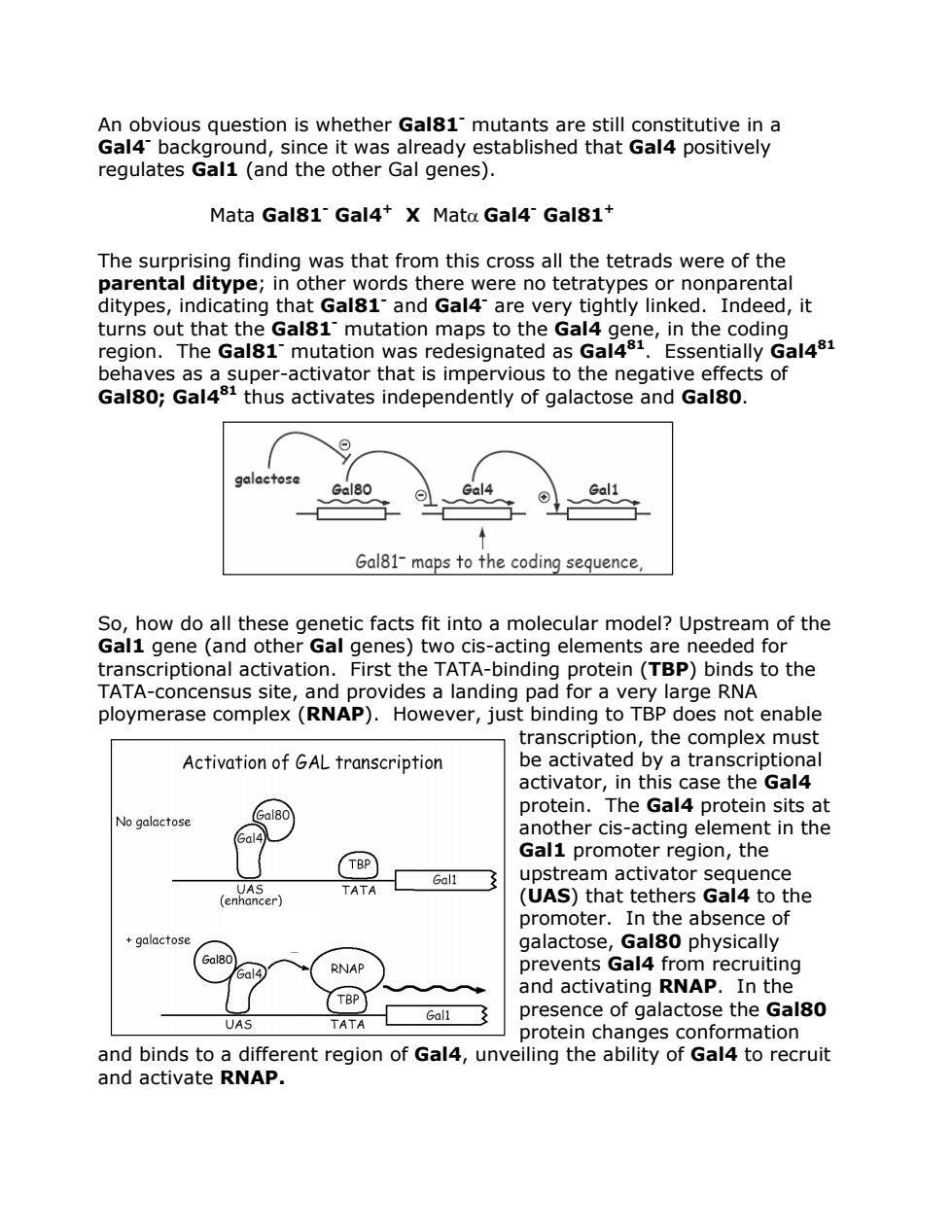正在加载图片...

An obvious question is whether Gal81 mutants are still constitutive in a Gal4 background,since it was already established that Gal4 positively regulates Gall (and the other Gal genes). Mata Gal81 Gal4+X Mata Gal4 Gal81+ The surprising finding was that from this cross all the tetrads were of the parental ditype;in other words there were no tetratypes or nonparental ditypes,indicating that Gal81and Gal4 are very tightly linked.Indeed,it turns out that the Gal81-mutation maps to the Gal4 gene,in the coding region.The Gal81"mutation was redesignated as Gal481.Essentially Gal481 behaves as a super-activator that is impervious to the negative effects of Gal80;Gal431 thus activates independently of galactose and Gal80. ⊙ galactose Gal80 Gal4 Gal1 Gal81-maps to the coding sequence, So,how do all these genetic facts fit into a molecular model?Upstream of the Gal1 gene (and other Gal genes)two cis-acting elements are needed for transcriptional activation.First the TATA-binding protein(TBP)binds to the TATA-concensus site,and provides a landing pad for a very large RNA ploymerase complex(RNAP).However,just binding to TBP does not enable transcription,the complex must Activation of GAL transcription be activated by a transcriptional activator,in this case the Gal4 protein.The Gal4 protein sits at No galactose Gal80 another cis-acting element in the Gal1 promoter region,the TBP Gal1 upstream activator sequence UAS TATA (enhancer) (UAS)that tethers Gal4 to the promoter.In the absence of galactose galactose,Gal80 physically Gal80 Gal4 RNAP prevents Gal4 from recruiting and activating RNAP.In the TBP Gal1 presence of galactose the Gal80 UAS TATA protein changes conformation and binds to a different region of Gal4,unveiling the ability of Gal4 to recruit and activate RNAP.An obvious question is whether Gal81- mutants are still constitutive in a Gal4- background, since it was already established that Gal4 positively regulates Gal1 (and the other Gal genes). Mata Gal81- Gal4+ X Matα Gal4- Gal81+ The surprising finding was that from this cross all the tetrads were of the parental ditype; in other words there were no tetratypes or nonparental ditypes, indicating that Gal81- and Gal4- are very tightly linked. Indeed, it turns out that the Gal81- mutation maps to the Gal4 gene, in the coding region. The Gal81- mutation was redesignated as Gal481. Essentially Gal481 behaves as a super-activator that is impervious to the negative effects of Gal80; Gal481 thus activates independently of galactose and Gal80. So, how do all these genetic facts fit into a molecular model? Upstream of the Gal1 gene (and other Gal genes) two cis-acting elements are needed for transcriptional activation. First the TATA-binding protein (TBP) binds to the TATA-concensus site, and provides a landing pad for a very large RNA ploymerase complex (RNAP). However, just binding to TBP does not enable transcription, the complex must be activated by a transcriptional activator, in this case the Gal4 protein. The Gal4 protein sits at another cis-acting element in the Gal1 promoter region, the upstream activator sequence (UAS) that tethers Gal4 to the promoter. In the absence of galactose, Gal80 physically prevents Gal4 from recruiting and activating RNAP. In the presence of galactose the Gal80 protein changes conformation and binds to a different region of Gal4, unveiling the ability of Gal4 to recruit and activate RNAP. Gal80